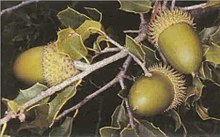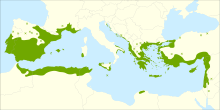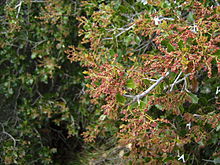| This article needs additional citations for verification. Please help improve this article by adding citations to reliable sources. Unsourced material may be challenged and removed. Find sources: "Quercus coccifera" – news · newspapers · books · scholar · JSTOR (June 2013) (Learn how and when to remove this message) |
| Kermes oak | |
|---|---|

| |
| Conservation status | |
 Least Concern (IUCN 3.1) | |
| Scientific classification | |
| Kingdom: | Plantae |
| Clade: | Tracheophytes |
| Clade: | Angiosperms |
| Clade: | Eudicots |
| Clade: | Rosids |
| Order: | Fagales |
| Family: | Fagaceae |
| Genus: | Quercus |
| Subgenus: | Quercus subg. Cerris |
| Section: | Quercus sect. Ilex |
| Species: | Q. coccifera |
| Binomial name | |
| Quercus coccifera L. | |

| |
| Distribution map | |
| Synonyms | |
List
| |
Quercus coccifera, the kermes oak or holly oak, is an oak shrub or tree in section Ilex of the genus. It has many synonyms, including Quercus calliprinos. It is native to the Mediterranean region and Northern African Maghreb, south to north from Morocco to France and west to east from Portugal to Cyprus and Turkey, crossing Spain, Italy, Libya, the Balkans, and Greece, including Crete. The Kermes oak was historically important as the food plant of Kermes scale insects, from which a red dye called crimson was obtained. The etymology of the specific name coccifera is related to the production of red cochineal (crimson) dye and derived from Latin coccum which was from Greek κόκκος, the kermes insect. The Latin -fera means 'bearer'.
Description
Quercus coccifera is usually a shrub less than 2 metres (6+1⁄2 feet) high, rarely a small tree, reaching 1–6 metres (3+1⁄2–19+1⁄2 ft) tall (with 10 m or 33 ft specimens recorded in Kouf, Libya) and 50 centimetres (20 inches) in trunk diameter. It is evergreen, with spiny-serrated coriaceous leaves 1.5–4 cm long and 1–3 cm broad. The acorns are 2–3 cm long and 1.5–2 cm in diameter when mature about 18 months after pollination. They are held in a cup covered in dense, elongated, reflexed scales.
It blooms from March to May in weather still wet. It is easily propagated by seed, an acorn that lies dormant until germinated by wet weather. This might occur anywhere from late summer to late autumn or early winter (October, November or December) of the following year. The acorns are very bitter, varying greatly in size and shape from one specimen to another and tasting bad. Acorns can germinate even before falling from the plant, but Q. coccifera is also multiplied by root suckers and layering.
Gallery
-
Trunk
-
Leaves on branch
-
Leaves
-
Close-up of leaves
-
 Acorns
Acorns
-
 Kermes oak in Kythera
Kermes oak in Kythera
Taxonomy
Quercus coccifera
Quercus coccifera was first described by Carl Linnaeus in 1753. It is called "chêne des garrigues" (garrigue oak) in French. The term "garrigue" comes from Catalan or Occitan "garric" (meaning "twisted") the name for Q. coccifera in those languages. The common Spanish name of Q. coccifera is chaparro, which refers to its small size, a feature it shares with other oak species in similar habitats in other parts of the world, such as the chaparral communities from various parts of the Americas. The word chaparro comes from the Basque txapar meaning "little thicket". Quercus coccifera is placed in section Ilex.
Quercus calliprinos
Quercus calliprinos Webb, syn. Quercus coccifera subsp. calliprinos (Webb) Holmboe, the 'Palestinian oak' of the eastern Mediterranean, has been distinguished from the kermes oak by its larger size (more often a tree, up to 18 m) and larger acorns over 2 cm diameter. In Israel it is called the 'common oak' (Hebrew: אלון מצוי, IPA: [a'lon ma'tsuj]) or the 'Palestine oak'. As of February 2023, Plants of the World Online regards it as a synonym of Quercus coccifera, but this is widely disputed, with many authors, particularly in the eastern Mediterranean, considering it distinct at least at subspecies rank, if not as a species.
Distribution and habitat

Quercus coccifera is an important Mediterranean bush or dwarf vegetation, where the biome it dominates often bears its name (maquis, coscojar, garrigue, carrascal, chaparral, etc.). Q. coccifera forms monospecific communities or communities integrated with Pinus, mediterranean buckthorns, Myrtus, Arecaceae, junipers, Pistacia, Rosmarinus, Thymus, etc.
It is located throughout the region around the Mediterranean Sea, especially in central southern and eastern halves. It is similarly found on islands in the Mediterranean, from the Balearic Islands to Cyprus. It is common in Crete and can survive heavy sheep and goat grazing for long periods as a ground cover a few centimeters high. The same is true in Mallorca, Ibiza and the Iberian Peninsula.
The species grows on dry, sunny slopes. It supports both subhumid climates with dry summers or semi-desert climates with rainfall between 400 and 600 millimetres (16 and 24 in). A very hardy species, it grows well in all types of soils as a shrub, withstanding overgrazing. It is indifferent to soil chemistry, living on calcareous, pebbly, stony and poor soils. A lover of warm weather, it starts to fail from 1,000 m (3,300 ft) above sea level. It is capable of supporting the continental Mediterranean climate with more extreme temperatures and low rainfall, replacing Quercus ilex (holm oak) in drier areas where it excels in drought resistance. It also grows on sea cliffs and in windy areas where other species of Quercus or Pinus cannot resist the harsh weather conditions.
Ecology

Populations typically occur in desert regions without any inhabited nucleus because crops are not economically profitable and the climate becomes progressively more continental and drier and therefore end in extreme temperatures accompanied by slow-growing dwarf juniper species. It is the last species of genus Quercus to disappear when rainfall is lacking. Their ecological importance is as a habitat and food source in these areas (they have edible acorns, although with a very bitter taste) for nesting birds, foxes, rodents and wild boars. It forms thickets, thorny and dense, some recorded as tall as 5 m. It is sometimes accompanied by other plant species of the same size and climber plants such as asparagus or Mediterranean smilax.
Q. coccifera is associated with several asparagus species, Crataegus monogyna, Mediterranean dwarf palm, ephedra, myrtle, several species of Junipers (Juniperus, sabinas...), Pistacia terebinthus, mastic, wild Olea europea, sarsaparilla, Rhamnus atlantica, Rhamnus lycioides, Rhamnus oleoides, Rhamnus catharticus etc. The communities receiving several characteristic names.
Kermes oaks have become scarce due to their replacement in wet zones by larger species such as Holm oak. It has also suffered from extensive culling for use as charcoal. It is the only food and shelter for wildlife in some areas, such as the Ebro valley and other dry areas where chaparral replaces oaks due to low rainfall.
It can survive heavy sheep and goat grazing for a long time as a ground carpet a few cm high, and will grow higher as a bush or a tree according to how much the grazing pressure is slackened.
Conservation
It is included as an endangered species in the Red Book of Bulgaria.
Notable specimens
In the village of Kalopanagiotis, Cyprus, the tallest tree of this species has grown to a height of 17 meters. The tree is approximately 700 years old.
See also
References
- Gorener, V.; Barstow, M. & Harvey-Brown, Y. (2018). "Quercus coccifera". IUCN Red List of Threatened Species. 2018: e.T194078A2296598. doi:10.2305/IUCN.UK.2018-1.RLTS.T194078A2296598.en. Retrieved 25 January 2024.
- ^ "Quercus coccifera L." Plants of the World Online. Royal Botanic Gardens, Kew. Retrieved 2023-02-21.
- ^ "Are Quercus calliprinos and Q. coccifera the Same or Distinct Species?". International Oak Society. 2023-12-04. Retrieved 2024-11-11.
- Denk, Thomas; Grimm, Guido W.; Manos, Paul S.; Deng, Min; Hipp, Andrew L. (2017), Gil-Pelegrín, Eustaquio; Peguero-Pina, José Javier; Sancho-Knapik, Domingo (eds.), "An Updated Infrageneric Classification of the Oaks: Review of Previous Taxonomic Schemes and Synthesis of Evolutionary Patterns" (PDF), Oaks Physiological Ecology. Exploring the Functional Diversity of Genus Quercus L., Cham: Springer International Publishing, pp. 13–38, doi:10.1007/978-3-319-69099-5_2, ISBN 978-3-319-69099-5, retrieved 2022-11-16
- Young, Frank N. Jr; Kritsky, Gene (2002). A Survey of Entomology. San Jose: Writers Club Press. p. 9. ISBN 0-595-22143-2.
- "Cochineal".
- "Important bird areas fact sheet: Jabal al Akhdar". BirdLife International. Archived from the original on 2014-02-22. Retrieved 2013-06-22.
- "chaparral". Online Etymology Dictionary. Douglas Harper. Retrieved 2013-06-22.
- Denk, Thomas; Grimm, Guido W.; Manos, Paul S.; Deng, Min & Hipp, Andrew L. (2017). "Appendix 2.1: An updated infrageneric classification of the oaks" (xls). figshare. doi:10.6084/m9.figshare.5547622.v1. Retrieved 2023-02-18.
- "Quercus coccifera". Red Book of Bulgaria, vol. 1. Retrieved 19 January 2017.
| Sources of tannins | |||||||||||||||||
|---|---|---|---|---|---|---|---|---|---|---|---|---|---|---|---|---|---|
| Sources of condensed tannins |
| ||||||||||||||||
| Sources of hydrolysable tannins |
| ||||||||||||||||
| Other sources by organ |
| ||||||||||||||||
| Taxon identifiers | |
|---|---|
| Quercus coccifera |
|